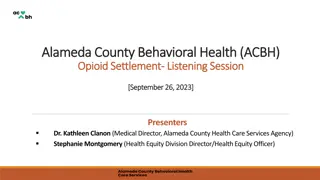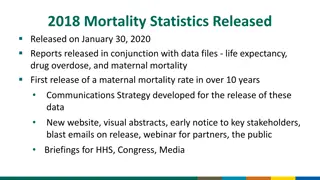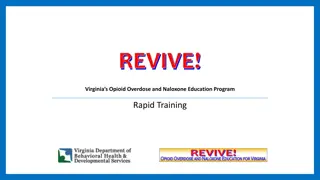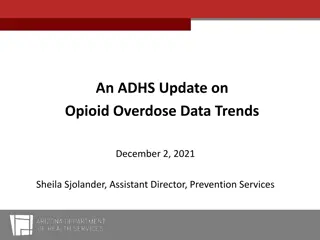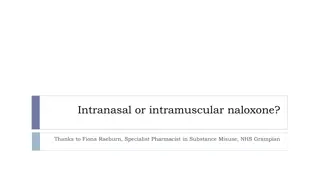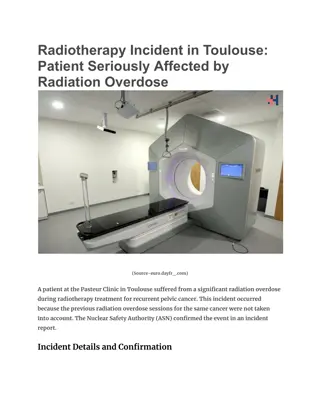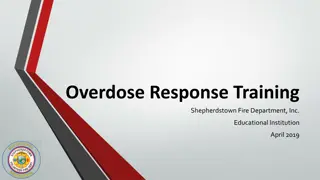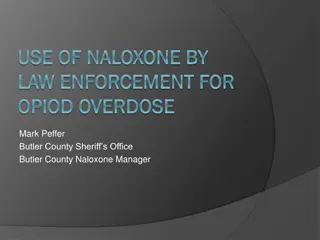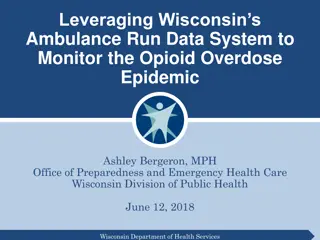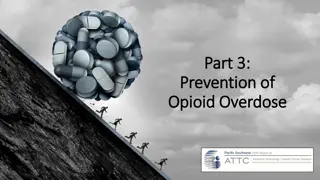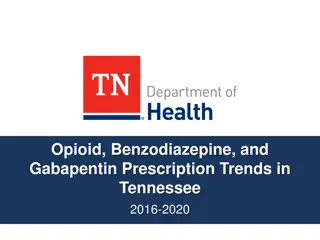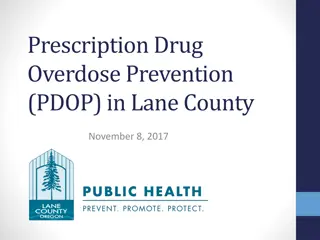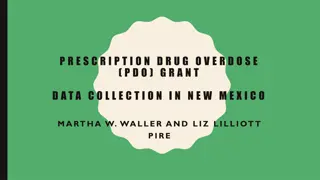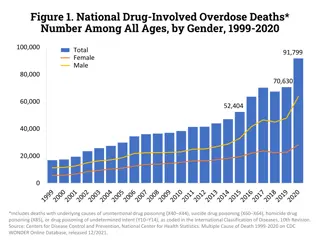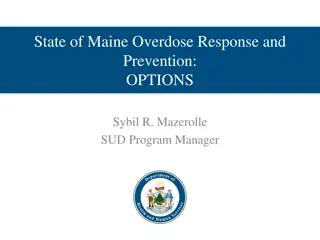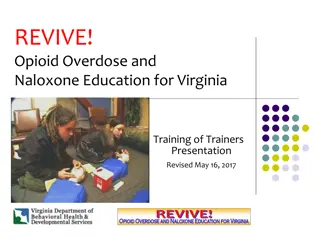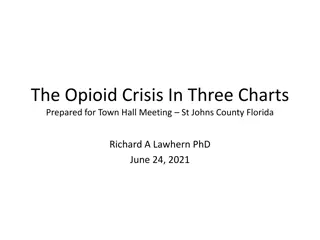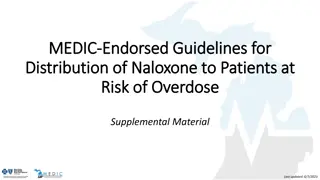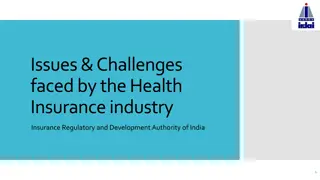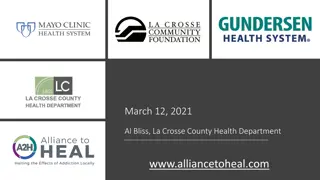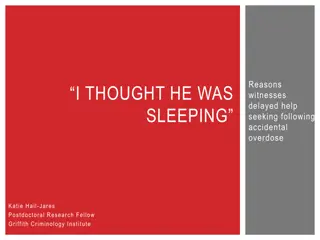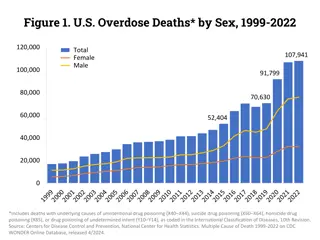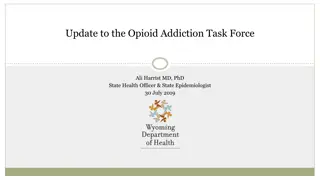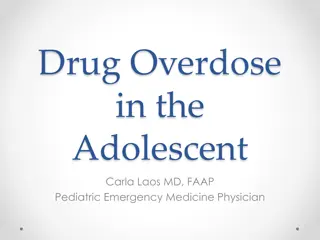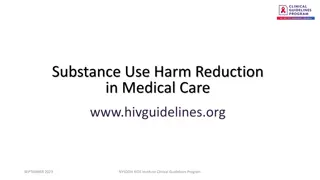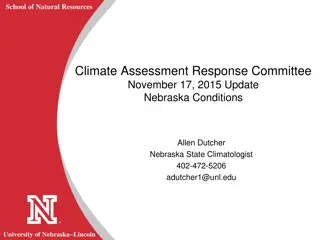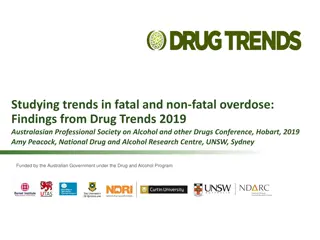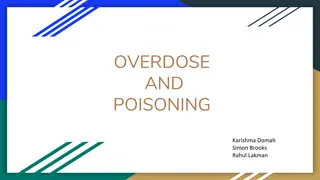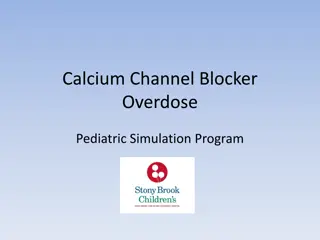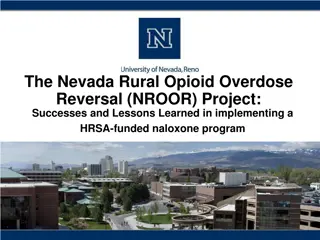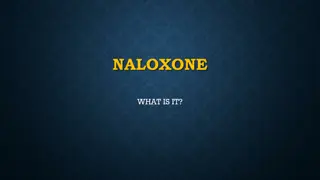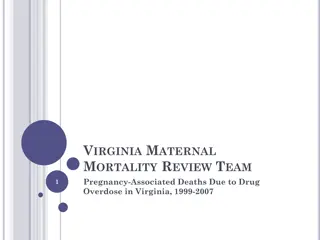The Power of Collaboration in Harm Reduction and Public Safety Partnerships
Learn about successful collaborations in harm reduction and public safety to prevent overdose, featuring insights from various presenters and an overview of pilot projects supported by the National Council and CDC. The webinar emphasizes evidence-based strategies, integration of harm reduction and p
1 views • 31 slides
Opioid Use Disorder Treatment Guidelines 2024
The February 2024 NYSDOH AIDS Institute Clinical Guidelines Program focuses on assisting clinicians in engaging with patients about opioid use disorder (OUD) treatment goals, emphasizing overdose prevention, providing updated information on available treatment options, and offering recommendations f
2 views • 24 slides
Children's and Mothers' Health Trends in Northern Ireland 2021/22
Children's health in Northern Ireland showed various trends in 2021/22, including a high rate of infants born by Caesarean section, percentages of pre-term births, multiple births, infants breastfed, low and high birth weights, and overweight and obese children. Mothers' summary in 2020/21 indicated
1 views • 23 slides
Alameda County Behavioral Health Opioid Settlement Listening Session
Alameda County Behavioral Health (ACBH) conducted a listening session on September 26, 2023, addressing the opioid crisis, definitions of opioids, medication-assisted treatments, and current data on overdose deaths in the county. The session highlighted the rapid increase in opioid-related overdose
1 views • 31 slides
2018 Mortality Statistics: Life Expectancy, Drug Overdose, Maternal Mortality Released
Mortality statistics for 2018 were released on January 30, 2020, highlighting life expectancy trends, drug overdose statistics, and the first maternal mortality rate in over a decade. A comprehensive communications strategy was executed to disseminate the data, including a new website, visual abstra
0 views • 9 slides
Overview of Opioid Crisis in North America and Africa
The opioid crisis in North America and Africa presents common threats and differing dynamics. Factors such as ease of manufacturing, interchangeability of fentanyl and tramadol, and market dynamics contribute to the crisis. In North America, high rates of prescription opioids have led to diversion a
1 views • 26 slides
Understanding Opioid Overdose and Naloxone Education Program in Virginia
The Virginia Opioid Overdose and Naloxone Education Program provide rapid training on opioids, overdose risks, naloxone usage, and emergency response protocols. Opioids include various drugs with potential overdose risk factors such as prior overdoses, reduced tolerance, mixing drugs, and certain me
0 views • 8 slides
Opioid Overdose Data Trends in Arizona
More than 5 Arizonans died from opioids daily in 2020. Opioid deaths totaled 2,500, with varying impacts on different counties. The monthly number of deaths peaked in mid-2020, declined, but increased again in 2021. CDC reported 2,005 opioid-related deaths in April 2021. The majority of fatal and no
0 views • 13 slides
Upland Cotton Quality Trends and Analysis 2022-23
Explore the latest trends in U.S. upland cotton quality for the 2022-23 crop, including fiber competition data, yield trends, micronaire distribution, average micronaire values, regional comparisons, strength trends, and distribution. Gain insights into micronaire levels, yield trends, and strength
0 views • 30 slides
Nasal vs Intramuscular Naloxone: A Comparison for Opioid Overdose Response
When administering naloxone for opioid overdose, choosing between nasal spray and intramuscular injection involves considerations such as ease of use, effectiveness in various conditions, and duration of action. Both methods have their advantages and may depend on individual circumstances. Nasal nal
0 views • 11 slides
Patient Seriously Affected by Radiation Overdose
A patient at the Pasteur Clinic in Toulouse suffered from a significant radiation overdose during radiotherapy treatment for recurrent pelvic cancer.
0 views • 3 slides
Understanding Opioid Overdose Response Training
Learn about opioids, recognizing opioid overdose, and responding to emergencies in this educational training by Shepherdstown Fire Department. Get insights on opioid receptors, hierarchy of opioids, chemical anatomy, and factors putting individuals at risk. Equip yourself with the knowledge to admin
0 views • 29 slides
Naloxone Use by Law Enforcement for Opioid Overdose: Importance and Benefits
Naloxone is a critical medication used by law enforcement to reverse opioid overdoses. The Davids Law-Opioid Overdose Reversal Act allows first responders to possess and administer Naloxone. The Good Samaritan Provision provides immunity to those calling for help during an overdose. Naloxone works b
0 views • 36 slides
Monitoring Wisconsin's Opioid Overdose Epidemic Through Ambulance Data
Utilizing Wisconsin's Ambulance Run Data System (WARDS), this initiative aims to enhance opioid overdose surveillance by analyzing nonfatal overdose data in real-time. By developing specific case definitions and identifying key variables of interest, the project seeks to improve the timeliness of mo
0 views • 25 slides
Understanding Opioid Overdose and Prevention Methods
The World Health Organization defines opioid overdose as a condition that can lead to respiratory depression and death, often identified by pinpoint pupils, unconsciousness, and respiratory depression. The statistics show a concerning rise in opioid-related deaths, emphasizing the urgent need for pr
0 views • 13 slides
Opioid, Benzodiazepine, and Gabapentin Prescription Trends in Tennessee 2016-2020
This report highlights the trends in opioid, benzodiazepine, and gabapentin prescriptions in Tennessee from 2016 to 2020. It addresses the increasing rates of drug overdose deaths, particularly opioid-related deaths. The data presented shed light on the measures and trends to combat the opioid crisi
0 views • 52 slides
Comprehensive Overview of Prescription Drug Overdose Prevention Efforts in Lane County
Efforts in Lane County to prevent prescription drug overdose include forming alliances, organizing educational sessions for prescribers, promoting Naloxone access, and engaging with the community and law enforcement. Initiatives also involve monitoring and addressing risky prescribing practices and
0 views • 13 slides
Training and Data Collection Tools for Prescription Drug Overdose Grant in New Mexico
This information provides insights into a Prescription Drug Overdose grant program in New Mexico, focusing on training and distributing Naloxone to combat opioid overdose. The program involves a hub and spoke system, where entities like county organizations and local agencies play crucial roles in t
0 views • 22 slides
Trends in National Drug-Involved Overdose Deaths from 1999-2020
The figures depict the alarming rise in drug-involved overdose deaths in the United States over the period 1999-2020. Figure 1 shows the number of deaths by gender, Figure 2 highlights specific drug categories involved, Figure 3 focuses on opioid-related deaths categorized by gender, and Figure 4 de
0 views • 10 slides
Maine Overdose Response and Prevention Program Overview
The State of Maine's Overdose Response and Prevention Program aims to combat substance use disorders through community-based initiatives, public messaging campaigns, and harm reduction strategies. The program includes elements such as community recovery partners, embedded SUD clinicians in first res
0 views • 11 slides
Understanding REVIVE! Opioid Overdose and Naloxone Education Training
This presentation covers the REVIVE! training program in Virginia, focusing on opioid overdose response, naloxone education, legislation surrounding safe reporting of overdoses, and the goals of training lay rescuers in recognizing and reversing opioid overdoses.
0 views • 48 slides
Insights on the Opioid Crisis: Analyzing CDC Data and Policy Recommendations
Delve into the complexities of the opioid crisis through an examination of CDC data depicting the relationship between opioid addiction and overdose deaths. Contrary to popular belief, the crisis is not solely attributed to physicians over-prescribing opioids. Gain a deeper understanding of who is p
0 views • 10 slides
Job Corps Physician Monthly Teleconference and Opioid Overdose Response Guidelines
Job Corps conducts a monthly teleconference for physicians across different regions. Zero new cases of COVID-19 among Job Corps students were reported. Guidelines for responding to opioid overdose in Job Corps include the availability of Narcan kits in various locations and staff training on recogni
0 views • 27 slides
Powercor Industry Forum Audit Results and Trends Analysis
Audit results and trends analysis reveal that there were 256 audits completed, with 50 being re-audits. Additional resources were acquired to meet industry demand, but audit volumes in Q4 did not meet forecast. Turnaround times improved with the deployment of more auditor resources. Trends show issu
0 views • 8 slides
Understanding Opioid Epidemic Impact & Harm Reduction in Michigan
The Michigan Emergency Department Improvement Collaborative (MEDIC) works to improve emergency care quality, with a focus on opioid overdose. Over 3,000 Michiganders died from opioid overdose in 2021, exceeding motor vehicle-related deaths. Harm reduction strategies, like distributing naloxone in ED
0 views • 10 slides
Challenges and Trends in India's Health Insurance Industry
The Health Insurance Regulatory and Development Authority of India faces various challenges and trends within the health insurance industry. The content discusses issues such as trends in health insurance premiums, stakeholder involvement, policyholder protection, and perspectives from insurers and
0 views • 22 slides
Opioid Crisis and Prevention Efforts in La Crosse County
La Crosse County is tackling the opioid crisis through the Alliance to HEAL initiative, aiming to limit opioid supply, raise awareness, and reduce addiction, deaths, and crime. Data shows drug overdose deaths and opioid use trends from 2014 to 2020, highlighting the need for collaborative efforts to
0 views • 13 slides
Delays in Seeking Help Following Accidental Overdose: Understanding Witnesses' Perspectives
Exploring the reasons behind witnesses delaying help-seeking after an accidental overdose, this study by Katie Hail-Jares delves into incarceration, loss of tolerance, social support systems, and witness behavior. It highlights the challenges of witness reporting in substance use settings and the im
0 views • 19 slides
Opioid Overdose Deaths in the U.S.: Trends and Analysis
The figures illustrate the concerning rise in opioid overdose deaths in the United States from 1999 to 2022. Graphs depict overdose deaths by sex, specific drugs or drug categories, involvement of opioids, and prescription opioids. The data highlights the impact of opioids on both genders and the ro
0 views • 10 slides
Update on Opioid Addiction Task Force with State Health Officer Ali Harrist - July 2019
Review of data on overdose deaths, indicators of opioid use, and special populations by the Opioid Addiction Task Force led by Ali Harrist, MD, PhD. The update covers activities of the Public Health Division, Behavioral Health Division, and Vital Statistics Services in Wyoming. Data sources include
0 views • 33 slides
Understanding Adolescent Drug Overdose and Suicide Risks
This presentation dives into the concerning epidemiology of adolescent drug overdose and suicide, discussing various ingestions such as Skittles parties, marijuana, alcohol, and OTC medications. It sheds light on the role of social media in adolescent substance abuse and highlights risk factors, inc
0 views • 42 slides
Drug Task Force: Addressing Rising Heroin Overdose Cases
A collaborative Drug Task Force is working to address the increase in young adults aged 18 to 26 facing heroin overdoses, often in cardiac arrest. With a mission to promote awareness, educate, and support those struggling with addiction, the task force aims to provide cutting-edge medical care and c
0 views • 57 slides
Substance Use Harm Reduction in Medical Care Guidelines
This guideline aims to promote practical harm reduction strategies to mitigate negative consequences linked with substance use. It emphasizes healthcare clinicians to provide medical care, including screening for HIV and HCV, for patients using substances. It also suggests offering harm reduction co
0 views • 15 slides
Climate Assessment Update: Nebraska Precipitation Trends and Impacts
Nebraska's recent climate assessment reveals varying precipitation trends across different regions. Positive short-term trends in the western part of the state indicate soil moisture recharge, while negative trends in south-central and southeast Nebraska pose challenges. A persisting dry signal for
0 views • 13 slides
Trends in Fatal and Non-Fatal Overdose: Drug Trends 2019 Conference Findings
Studying trends in fatal and non-fatal overdose at the Australasian Professional Society on Alcohol and other Drugs Conference in 2019, Amy Peacock presented findings funded by the Australian Government. The research involved analyzing data sources like cryptomarket data, mortality data, hospitaliza
0 views • 13 slides
Comprehensive Guide to Overdose and Poisoning Management
Poisoning and overdose are common occurrences with serious implications. They encompass various toxidromes and require a systematic approach covering risk assessment, resuscitation, investigations, supportive care, decontamination, antidotes, and disposition planning. Recognizing signs of poisoning
0 views • 25 slides
Calcium Channel Blocker Overdose in Pediatrics
Calcium channel blocker overdose is a critical condition that can be life-threatening, especially in children. The overdose can result in symptoms such as syncope, chest pain, weakness, and seizures due to the medication's effects on cardiovascular function. Prompt recognition and appropriate manage
0 views • 14 slides
Implementing Naloxone Program in Rural Nevada: Successes and Lessons Learned
The Nevada Rural Opioid Overdose Reversal (NROOR) Project focused on purchasing and distributing naloxone, training healthcare professionals, and improving health outcomes in rural areas with opioid overdose incidents. Led by dedicated project personnel and key partnerships, the program aimed to add
0 views • 33 slides
Understanding Naloxone and Overdose Prevention
Naloxone is a prescription medication used to reverse the effects of opioid drugs and prevent overdose deaths. Available in different forms, Naloxone can be administered by intramuscular injection or intranasal spray. Immediate intervention with Naloxone can save lives by reversing the effects of op
0 views • 8 slides
Analysis of Pregnancy-Associated Deaths Due to Drug Overdose in Virginia (1999-2007)
This report examines pregnancy-associated deaths in Virginia from 1999 to 2007, specifically focusing on cases related to drug overdose. Among the 397 cases reviewed, substance abuse was found to be a significant contributor to 24.2% of deaths, impacting various causes and manners of death including
0 views • 23 slides



